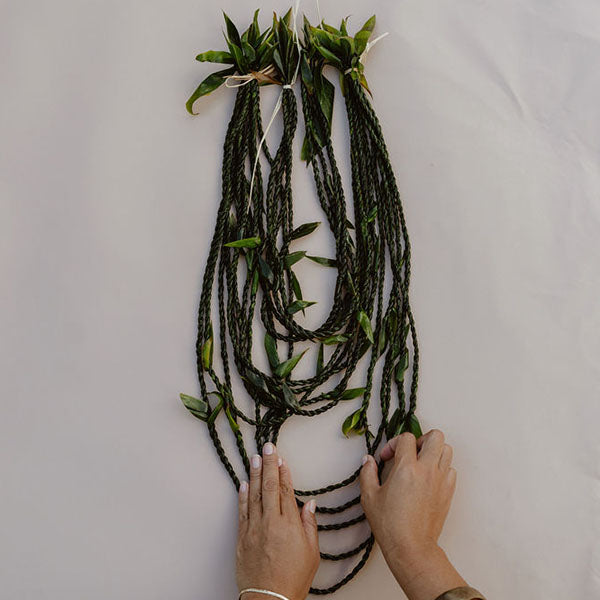Fashioning Lei: The Various Styles
April 28, 2022 – Kanani Durant

Fashioning Lei: The Various Styles
On Sunday, May 1, talented lei makers of all ages will submit their floral compositions into the annual Walter and Irmalee Pomroy May Day Lei Contest held at Kauaʻiʻs Royal Sonesta. Unique combinations of textures and tones will be carefully arranged and fastened using various lei styles to show the expertise and creativity of the lei makers. Here are the different styles to look for as you gaze at the detailed floral works of art.

Lei Hilo
This style is very popular and commonly seen using lāʻī or ti leaf. Hilo means to twist or braid and while it is used for lei it is also commonly used to make cordage. While one strand is fairly quick to create, multiple strands and variations of this type of lei are simply beautiful.

Lei Hili
Hili means to braid or plait. This type of lei is created by braiding only one lei material. The most common materials used in this type of lei are ferns and vines. Amongst the most popular materials are palapalai, maile, as well as kaunaoa.
Lei Hīpu’u/ Kīpu’u
Hipuʻu or kipuʻu means to knot, bond, fasten, and also refers to the act of tying a knot. This type of lei uses materials with a long, flexible stem. Some of the favorite lei materials for this type of lei are lau kūkui, the leaves of the kūkui tree. Hīpuʻu is also used to make single strands of lei maile. When a strand is not long enough, two or more strands are knotted to create one long strand.
Lei Haku
in lei making, haku refers to braiding or plaiting. Unlike the lei hili which uses only one material, a lei haku incorporates two or more materials into the lei. In this style, three strands of lāʻī are braided to secure the flowers and foliage while also hiding itʻs stems.

Lei Wili
Wili means to wind or twist. There are a few different styles of lei wili which include lei kāwili, lei wili papa, and lei wili poepoe,
Lei kāwili: This wili style twists individual strands together. The most common lei done in this style is Lei maile.
Lei wili papa - This wili style uses a base to help secure the foliage when wrapped. It is the most common technique used for lei poʻo (head lei).
Lei Wili Poepoe: In this wili style, flowers and foliage encircle the base.

Lei Kui
Kui refers to stringing of pierced objects and in this context flowers and foliage. It is the most common of lei styles and one of the first lei any aspiring lei maker will fashion. Like Lei wili, lei kui has different styles.
Lei kui pololei: This type of lei style strings materials lengthwise from end to end through the center of the flower.
Lei kui poepoe: This type of lei style, also referred to as double a lei, string materials crosswise through the stem. They are arranged similar to spokes in a wheel and are a much thicker lei than lei kui pololei.

Lei Humupapa
Humupapa means to sew to a backing and is common in feather lei. In this style, lei materials are sewn using string and needle onto a backing. Lei hulu pāpale, or feather lei that adorn hats, are usually done in this style.

2 comments
What a beautiful compilation of the amazing techniques of how to make lei!! I’m excited to learn more. Ty ty for this opportunity =)
Love this blog !!! So many different ways to make lei !!!! I’m gonna write it all down so i won’t forget !!! Mahalo !!